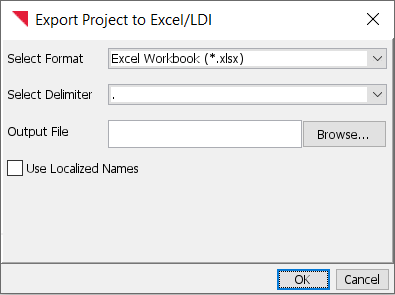Working with Excel Spreadsheets#
Lattix Architect provides a number of capabilities which makes it easy for you to work with Excel spreadsheets. These include:
The ability to create a DSM by reading an Excel spreadsheet using the Excel Module.
The ability to export a DSM to Excel spreadsheets through a script that has been created for this purpose.
Export a DSM to an Excel spreadsheet#
Lattix Architect provides a script ExportProject.groovy to generate an Excel spreadsheet or LDI from an existing Lattix Architect project. This script is included in the Complex System Profile and can be invoked by selecting Export Project to Excel/LDI from the Scripts menu.

The Export Project script generates an Excel spreadsheet in Column Format. The script is also designed to pick up any manual changes that you may have made. For instance, you may have added additional subsystems and created manual dependencies. You may also have added or modified structure through hierarchy changes. This script will generate atom names that includes the hierarchy in the names of the atoms that are generated. If you have multiple atoms (e.g. LDI or Manual) within a partition, the script will generate a single atom name based on the partition name, thereby aggregating the atoms and dependencies within a partition.
Important Note: Mixing Data from Multiple Sources#
Things can be confusing when you mix data from multiple sources, including data that you add manually as Manual Atoms and Dependencies.
Suppose you first define your Atoms and Dependencies in an Excel Spreadsheet and then load it into Lattix Architect using the Excel Module. The data source is the Excel file and the Atoms created are Excel Atoms. Now you edit that DSM within Lattix Architect by manually creating new atoms and dependencies. You will see that your project contains both Manual Atoms and Excel Atoms.
Lattix Architect has been designed to allow loading of Atoms and Dependencies from multiple sources. It is also designed to track the changes to those Atoms and Dependencies over a period of time. This means that you can create DSMs that look exactly the same in terms of partitions but actually contain different combination of Atoms and Dependencies from different sources that aggregate in the same way.
When you edit an Excel Atom or Dependency within Lattix Architect, then Lattix Architect will no longer track them as originating from Excel. Using the Export Project script enables you to create a new Excel data source. When the project is updated with the new Excel data source, the previously edited atoms and dependencies will have been converted to Excel Atoms and Dependencies.
